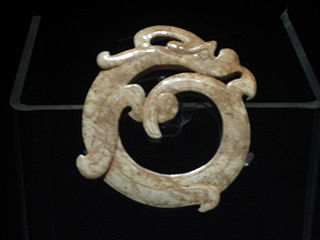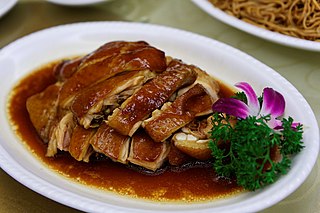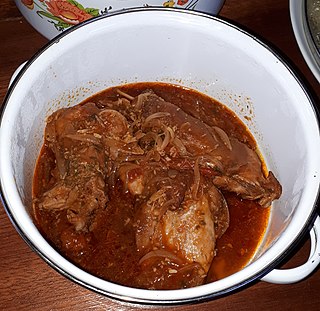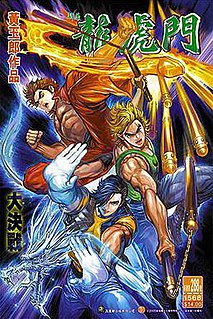Related Research Articles

Crouching Tiger, Hidden Dragon is a 2000 wuxia film directed by Ang Lee and written by Wang Hui-ling, James Schamus and Tsai Kuo Jung, based on the Chinese novel by Wang Dulu. The film features an international cast of Chinese actors, including Chow Yun-fat, Michelle Yeoh, Zhang Ziyi and Chang Chen.

Chinese dragon, also known as East Asian dragon or Long or Lung, are legendary creatures in Chinese mythology, Chinese folklore, and East Asian culture at large. Chinese dragons have many animal-like forms such as turtles and fish, but are most commonly depicted as snake-like with four legs. They traditionally symbolize potent and auspicious powers, particularly control over water, rainfall, typhoons, and floods. The dragon is also a symbol of power, strength, and good luck for people who are worthy of it in East Asian culture. During the days of Imperial China, the Emperor of China usually used the dragon as a symbol of his imperial strength and power.

Dim sum is a style of Chinese cuisine. It is prepared as small bite-sized portions of food served in small steamer baskets or on a small plate. Dim sum is generally considered Cantonese, although other varieties exist. Dim sum dishes are usually served with tea and together form a full tea brunch. Due to the Cantonese tradition of enjoying tea with this cuisine, yum cha, which means "drink tea" in Cantonese, is also synonymous with dim sum. Dim sum traditionally are served as fully cooked, ready-to-serve dishes. In some Cantonese teahouses, carts with dim sum are served around the restaurant.

Fenghuang, known in Japanese as Hō-ō or Hou-ou, are mythological birds found in East Asian mythology that reign over all other birds. The males were originally called feng and the females huang but such a distinction of gender is often no longer made and they are blurred into a single feminine entity so that the bird can be paired with the Chinese dragon, which is traditionally deemed male.

Panlong is an aquatic dragon resembling a jiaolong 蛟龍 "river dragon; crocodile" in Chinese mythology, an ancient motif in Chinese art, and a proper name.

Liuhebafaquan is a internal Chinese martial art. It has been called "Xinyi Liuhebafa" 心意六合八法拳 and is also referred to as "water boxing" due to its principles.

Soy sauce chicken is a traditional Cantonese cuisine dish made of chicken cooked with soy sauce. It is considered as a siu mei dish in Hong Kong.

Cellophane noodles, or fensi, sometimes called glass noodles, are a type of transparent noodle made from starch and water.
Di Nü Hua is a fictional Chinese story about Princess Changping of the Ming Dynasty and her husband/lover, Zhou Shixian. The first known story was a Kunqu script written in the Qing Dynasty, while the second version was a Cantonese opera from the early 1900s later found in Japan and Shanghai. Little information is available from this early 1900s version. The contemporary prevailing version, not meant to be historically accurate, comes from the second Cantonese opera script.
Yu So-chow was a Chinese actress. She was born in Beijing to a Peking opera family. She is the daughter of late Master Yu Jim Yuen who ran the China Drama Academy, a Peking Opera School in Hong Kong, and teacher of many well-known actors.

Canadian Chinese cuisine is a popular style of Canadian cooking exclusive to take-out and dine-in eateries found across Canada. It was the first form of commercially available Chinese food in Canada. This cooking style was invented by early Cantonese immigrants who adapted traditional Chinese recipes to Western tastes and the available ingredients. This cuisine developed in a similar process to American Chinese cuisine.

Cat meat is meat prepared from domestic cats for human consumption. Some countries eat cat meat regularly, whereas others have only consumed some cat meat in desperation during wartime or poverty.
Niu Heting, better known by his pen name Wolong Sheng, was a Chinese writer of wuxia novels.

Oriental Heroes is a popular Hong Kong-based manhua created by Wong Yuk-long, a writer/artist responsible for also creating a number of other popular manhua titles. It was created in 1970, and it continues to be published today. The book was the first Hong Kong manhua title based on action and fighting, often borrowing from the wuxia literary world. It established a new action genre of Hong Kong manhua and spawned many imitators. The theme of its stories often revolve around brotherhood and the fight for justice. The 2006 movie Dragon Tiger Gate was based on this manhua.

Shaoxing wine is one of the most famous varieties of huangjiu, or traditional Chinese wines, fermented from rice. It originates from the region of Shaoxing, in the Zhejiang province of eastern China. It is widely used as both a beverage and a cooking wine in Chinese cuisine. It is internationally well known and renowned throughout mainland China, as well as in Taiwan and Southeast Asia.
Chinese pre-wedding customs are traditional Chinese rituals prescribed by the 禮記 [láih gei], the 儀禮 [yìh láih] and the 白虎通 [baahk fú tùng] condensed into a series of rituals now known as the 三書六禮 [sàam syù luhk láih]. Traditionally speaking, a wedding that incorporates all six rites is considered a [daaih chéui].

Fengguan is a traditional type of Chinese headgear for women. It was worn mainly by noblewomen during the Ming dynasty for ceremonies or official occasions. It is also traditional headgear for brides.
Christopher John Lonsdale is a New Zealand psychologist, linguist and educator. His adopted Chinese name, Dragon Tiger, is 龙飞虎. Lonsdale created the Kungfu English learning system and is also the author of The Third Ear.

Tiger Mom is a 2015 Chinese television series starring Zhao Wei and Tong Dawei. It aired on Dragon TV and Tianjin TV from 3 May to 25 May 2015. The series revolves around a strong-willed disciplinarian tiger mother who faces mounting pressure raising her daughter, while her husband has an opposite view of how to raise their daughter. It marks acclaimed actress Zhao Wei's return to television after a 5-year absence.

Bashu culture, sometimes also named Chongqing-Sichuan culture, refers to the culture of Sichuan province and Chongqing city, China and the surrounding areas, including parts of the neighboring provinces of Yunnan and Guizhou, since the Han Chinese groups in these two provinces also primarily speak Southwestern Mandarin nowadays. It has a long history of over 3000 years, widely regarded as one of the cradles of modern Chinese civilization.
References
- 1 2 Big5.China.com. "China.com.cn." Cantonese cuisine. Retrieved on 2008-12-28.
- ↑ Newsweek.com. "Newsweek.com." Pet lovers protest cats on the menu in China. Retrieved on 2008-12-28.
- ↑ Huaxia. "Huaxia." 酒家與名肴. Retrieved on 2008-12-28.